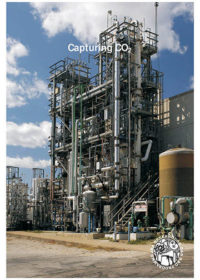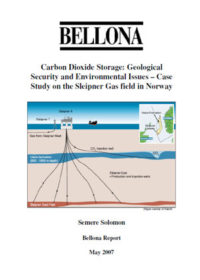Resources
Publications
Our publications, reports and research library hosts over 500 specialist reports and research papers on all topics associated with CCS.
View our Publication Library Disclaimer.
Filter by
Convention for the protection of the marine environment of the north-east atlantic
25th June 2007
Topic(s): Carbon capture use and storage (CCUS), Policy law and regulation
Disclaimer
The content within the Global CCS Institute Publications, Reports and Research Library is provided for information purposes only. We make every effort and take reasonable care to keep the content of this section up-to-date and error-free. However, we make no claim as to its accuracy, currency or reliability.
Content and material featured within this section of our website includes reports and research published by third parties. The content and material may include opinions and recommendations of third parties that do not reflect those held by the Global CCS Institute.
Amendments of Annex II and Annex III to the convention in relation to the storage of carbon dioxide streams in geological formations
25th June 2007
Topic(s): Carbon capture use and storage (CCUS)
Disclaimer
The content within the Global CCS Institute Publications, Reports and Research Library is provided for information purposes only. We make every effort and take reasonable care to keep the content of this section up-to-date and error-free. However, we make no claim as to its accuracy, currency or reliability.
Content and material featured within this section of our website includes reports and research published by third parties. The content and material may include opinions and recommendations of third parties that do not reflect those held by the Global CCS Institute.
OSPAR decision 2007/1 to prohibit the storage of carbon dioxide streams in the water column or on the sea-bed
25th June 2007
Topic(s): CO2 storage, Health safety and environment
Disclaimer
The content within the Global CCS Institute Publications, Reports and Research Library is provided for information purposes only. We make every effort and take reasonable care to keep the content of this section up-to-date and error-free. However, we make no claim as to its accuracy, currency or reliability.
Content and material featured within this section of our website includes reports and research published by third parties. The content and material may include opinions and recommendations of third parties that do not reflect those held by the Global CCS Institute.
OSPAR decision 2007/2 on the storage of carbon dioxide streams in geological formations
25th June 2007
Topic(s): CO2 storage, Health safety and environment
Disclaimer
The content within the Global CCS Institute Publications, Reports and Research Library is provided for information purposes only. We make every effort and take reasonable care to keep the content of this section up-to-date and error-free. However, we make no claim as to its accuracy, currency or reliability.
Content and material featured within this section of our website includes reports and research published by third parties. The content and material may include opinions and recommendations of third parties that do not reflect those held by the Global CCS Institute.
OSPAR guidelines for risk assessment and management of storage of CO2 streams in geological formations
25th June 2007
Topic(s): CO2 storage, Health safety and environment
Disclaimer
The content within the Global CCS Institute Publications, Reports and Research Library is provided for information purposes only. We make every effort and take reasonable care to keep the content of this section up-to-date and error-free. However, we make no claim as to its accuracy, currency or reliability.
Content and material featured within this section of our website includes reports and research published by third parties. The content and material may include opinions and recommendations of third parties that do not reflect those held by the Global CCS Institute.
Bellona's comments on carbon dioxide capture and storage under the Clean Development Mechanism
31st May 2007
Topic(s): Carbon capture use and storage (CCUS)
There is considerable agreement among experts that Carbon dioxide Capture and Storage (CCS) is a vital mitigation alternative for the coming decades. The potential of such technologies to reduce CO2 emissions from fossil fuel power generation is substantial. In addition, a transfer of CCS technologies from industrialised to developing countries can help ensure a more sustainable economic development.
Disclaimer
The content within the Global CCS Institute Publications, Reports and Research Library is provided for information purposes only. We make every effort and take reasonable care to keep the content of this section up-to-date and error-free. However, we make no claim as to its accuracy, currency or reliability.
Content and material featured within this section of our website includes reports and research published by third parties. The content and material may include opinions and recommendations of third parties that do not reflect those held by the Global CCS Institute.
Emissions of greenhouse gases are expected to cause climate change. The main greenhouse gas is carbon dioxide (CO2) and the major source of it is the combustion of fossil fuels to supply energy. Emissions can be reduced by a variety of measures, such as improving energy efficiency and developing alternative energy sources, like wind and solar power. However, a rapid move away from fossil fuels is unlikely as energy supply infrastructure has a long lifetime, and such a move could destabilise economies.
Another way to reduce emissions is to capture the CO2 that is released from fossil fuel-fired power plants and store it underground. This is the focus of this report, as power generation accounts for about one-third of CO2 emissions from fossil fuel use. The current leading technologies for power generation are pulverised fuel (PF) combustion steam cycles and natural gas combined cycles (NGCC). The IEA Greenhouse Gas R&D Programme (IEA GHG) has assessed the performance and costs of these power plants, both with and without the capture of CO2. Integrated Gasification Combined Cycle (IGCC) for the gasification of coal, which was included in the assessment, may be a suitable technology from which to capture CO2. A number of criteria were specified for all the studies to enable the results to be compared in a meaningful manner. The main specifications are listed in the Annex at the end of the report.
Disclaimer
The content within the Global CCS Institute Publications, Reports and Research Library is provided for information purposes only. We make every effort and take reasonable care to keep the content of this section up-to-date and error-free. However, we make no claim as to its accuracy, currency or reliability.
Content and material featured within this section of our website includes reports and research published by third parties. The content and material may include opinions and recommendations of third parties that do not reflect those held by the Global CCS Institute.
Carbon dioxide storage: geological security and environmental issues. Case study on the Sleipner gas field in Norway
1st May 2007
Topic(s): Carbon capture use and storage (CCUS), Health safety and environment
The Sleipner project is a commercial CO2 injection project and proved that CO2 capture and storage is a technically feasible and effective method for greenhouse mitigation. It further demonstrates that CO2 storage is both safe and has a low environmental impact. Monitoring is needed for a wide variety of purposes. Specifically, to ensure and document the injection process, verify the quantity of injected CO2 that has been stored by various mechanisms, demonstrate with appropriate monitoring techniques that CO2 remains contained in the intended storage formation(s). This is currently the principal method for assuring that the CO2 remains stored and that performance predictions can be verified.
Disclaimer
The content within the Global CCS Institute Publications, Reports and Research Library is provided for information purposes only. We make every effort and take reasonable care to keep the content of this section up-to-date and error-free. However, we make no claim as to its accuracy, currency or reliability.
Content and material featured within this section of our website includes reports and research published by third parties. The content and material may include opinions and recommendations of third parties that do not reflect those held by the Global CCS Institute.
An international regulatory framework for risk governance of carbon capture and storage
1st May 2007
Topic(s): Engineering and project delivery, Policy law and regulation
CO2 capture and storage (CCS) in geological structures and its possible risks have been topics of extensive study in recent years. In contrast, the legal and regulatory structures necessary to support widespread capture and long-term, secure storage have received far less attention. This essay seeks to bridge this gap by building on existing CCS risk literature and outlining some of the key components of an international risk governance framework necessary for the widespread diffusion of CCS. The discussion is summarized by making preliminary recommendations on attributes that an effective regulatory regime for CCS should possess.
Disclaimer
The content within the Global CCS Institute Publications, Reports and Research Library is provided for information purposes only. We make every effort and take reasonable care to keep the content of this section up-to-date and error-free. However, we make no claim as to its accuracy, currency or reliability.
Content and material featured within this section of our website includes reports and research published by third parties. The content and material may include opinions and recommendations of third parties that do not reflect those held by the Global CCS Institute.
Technical support for an enabling policy framework for carbon dioxide capture and geological storage
1st April 2007
Topic(s): Carbon capture use and storage (CCUS), Policy law and regulation
This paper presents a high level view of the key policy options for regulating CO2 capture and storage (CCS) activities in the EU. Also outlined are some suggested issues and amendments to existing EU legislation that will be required in order to clarify their scope, confer their provisions or remove them as potential barriers.
Disclaimer
The content within the Global CCS Institute Publications, Reports and Research Library is provided for information purposes only. We make every effort and take reasonable care to keep the content of this section up-to-date and error-free. However, we make no claim as to its accuracy, currency or reliability.
Content and material featured within this section of our website includes reports and research published by third parties. The content and material may include opinions and recommendations of third parties that do not reflect those held by the Global CCS Institute.
The liability of carbon dioxide storage
1st February 2007
Topic(s): Carbon capture use and storage (CCUS), Liability
This is a lengthy and detailed thesis including an introduction to both CCS and liability in the US, followed by a dissection of the different types of liability which may be relevant in this context including liability for induced seismicity, groundwater contamination, damage to human health or environment. Draws comparisons with liability for similar operations such as acid gas injection, natural gas storage and enhanced oil recovery using case studies. Concludes with 'lessons learned' and proposed liability scheme.
Disclaimer
The content within the Global CCS Institute Publications, Reports and Research Library is provided for information purposes only. We make every effort and take reasonable care to keep the content of this section up-to-date and error-free. However, we make no claim as to its accuracy, currency or reliability.
Content and material featured within this section of our website includes reports and research published by third parties. The content and material may include opinions and recommendations of third parties that do not reflect those held by the Global CCS Institute.
Carbon capture and storage: A legal perspective
1st January 2007
Topic(s): Carbon capture use and storage (CCUS), Policy law and regulation
This paper provides an up-to-date examination of a number of key existing CCS legal mechanisms and regulatory options at EU and international level and proposals for their change, which it is hoped, could eventually resolve some issues of legal ambiguity.
Disclaimer
The content within the Global CCS Institute Publications, Reports and Research Library is provided for information purposes only. We make every effort and take reasonable care to keep the content of this section up-to-date and error-free. However, we make no claim as to its accuracy, currency or reliability.
Content and material featured within this section of our website includes reports and research published by third parties. The content and material may include opinions and recommendations of third parties that do not reflect those held by the Global CCS Institute.











